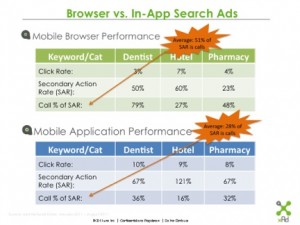Post-Click Activity Offers Key Mobile Attribution Insights
I wanted to take a deeper dive into mobile this month. It’s a hot topic that’s here to stay, and leading mobile ad network xAd recently shared some interesting and relevant stats. xAd’s local mobile ad network generates, on average, a click-through rate (CTR) of 5% to 8%, compared to an average general mobile network […]
I wanted to take a deeper dive into mobile this month. It’s a hot topic that’s here to stay, and leading mobile ad network xAd recently shared some interesting and relevant stats. xAd’s local mobile ad network generates, on average, a click-through rate (CTR) of 5% to 8%, compared to an average general mobile network CTR of 2.9%.
Mobile advertising is for real — and a huge opportunity for local. While smartphone adoption is growing exponentially — even without an iPhone 5 yet — 70% of the mobile market today is still on a feature phone, which means mobile marketing strategies must be multi-modal.
Secondary Action Rates In Mobile Browser Vs. In-App Ads
 In looking at usage of local search apps on smartphones vs. feature phone users’ local searches via a mobile browser, xAd found that engagement, and by extension attribution, can’t be measured solely by a click.
In looking at usage of local search apps on smartphones vs. feature phone users’ local searches via a mobile browser, xAd found that engagement, and by extension attribution, can’t be measured solely by a click.
They go as far as saying that it’s a mistake to determine mobile performance on an initial click as there is so much activity beyond that point in what they call the SAR (Secondary Action Rate).
Often times in mobile — and I would argue in almost all media channels — what happens post-click is most important.
The general trend is that in-app local mobile ads have a higher CTR and lower secondary action call rate, while mobile browser-based ads have a lower CTR and higher second-action call rate.
In looking at three distinct categories — Dentists, Hotels and Pharmacies — the CTR averages 5% for a mobile browser and 9% for mobile apps. While the SAR averages 44% for mobile browsers and 85% for apps, calls make up 51% of mobile browser-based SAR and 28% of app-based SAR.
Mobile browsing is cumbersome as only 20% of businesses have a mobile landing page or mobile site, so detailed business information can be harder to find or follow. This, in part, drives mobile consumers to make calls for more info.
Also, making a call once you’ve identified a business is sometimes just a more direct way to get the information needed to make a purchase decision. This reinforces the need to track secondary action calls.
Treat Browser / App Strategy Holistically
All in all, this data is a reminder to look comprehensively at your available ad performance metrics — including all possible interactions, e.g., clicks, calls, email, driving directions and QR codes — and have a strategy for managing them.
Easy to manage dashboards that enable valuable comparisons and evaluations that don’t overcomplicate are key to understanding and managing attribution.
With 7% to 10% of all web traffic now coming from a mobile phone and, according to our internal data, more than 50% of all calls placed to local search ads coming from mobile phones, you can’t think of a mobile strategy just in terms of app or browser.
Mobile must be addressed holistically to best reach the diverse mix of feature phone and smartphone users spread across multiple operating systems and numerous devices.
Similarly, not all apps are created equal. Mobile local search app engagement is higher than engagement with mobile local sites and app performance ties back direct to products with immediate, nearby and actionable content. Make sure the apps you enable have these direct connections.
Lastly, look for a mobile ad solution that enables you to place ads across multiple applications with one buy and offers pay for performance options. Today some providers are going beyond even clicks and calls and allowing advertisers to pay for drives.
Contributing authors are invited to create content for Search Engine Land and are chosen for their expertise and contribution to the search community. Our contributors work under the oversight of the editorial staff and contributions are checked for quality and relevance to our readers. The opinions they express are their own.
Related stories